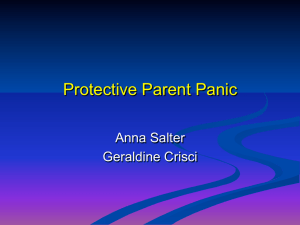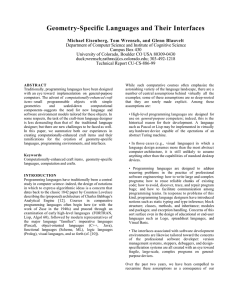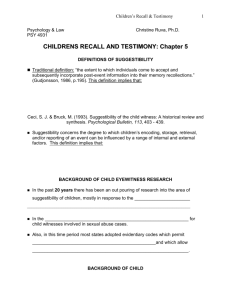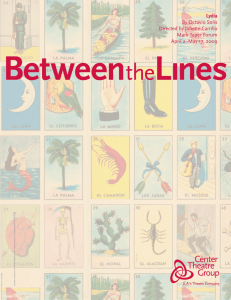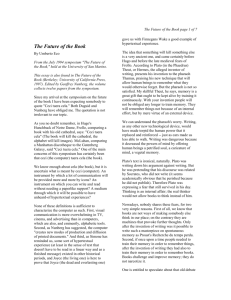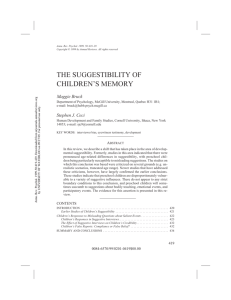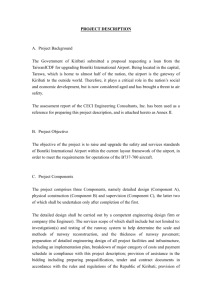Leichtman & Ceci, 1995
advertisement
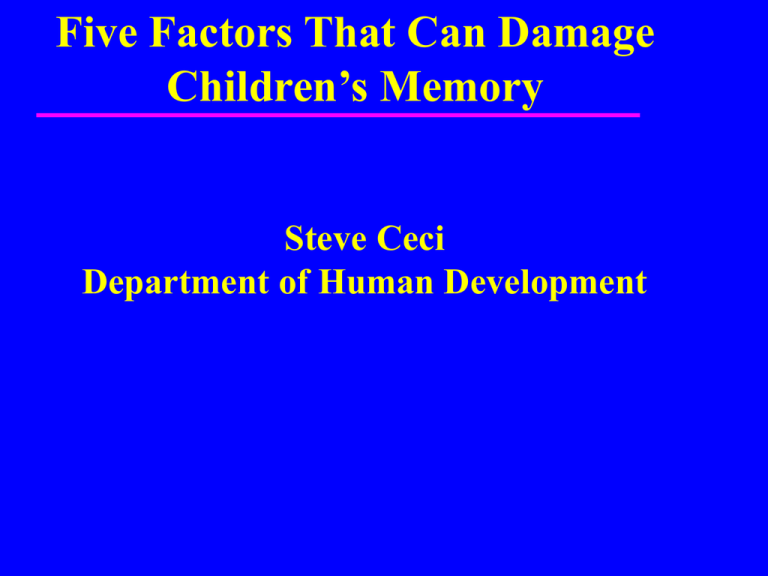
Five Factors That Can Damage Children’s Memory Steve Ceci Department of Human Development Are children’s statements accurate? 2 Ways for Statements to be Inaccurate lies false memory/false belief What is memory? Memory is a record of: pattern-recognition interpretive analyses source information Source Memory Memory for the root of information acquisition A record is made of the context of remembering Jargon #1 Source Misattributions Source Misattributions - what are they? Even adults are vulnerable (20%-35%) Preschoolers are disproportionately vulnerable (50-70%) • “One day in the summer of 1901, I remarked to a friend with whom I used to have a lively exchange of scientific ideas: ‘These problems of the neuroses are only to be solved if we base ourselves on the assumption of the original bisexuality of the individual.’ To which he replied: ‘That’s what I told you two years ago at Breslau when we went for that evening walk. But you wouldn’t hear of it then’. It is painful to be requested in this way to surrender one’s originality.” (Freud, 1901, p. 141) Five Factors That Can Damage Memory Suggestive questions (Ceci, et al, 1987) Stereotypes (Leichtman & Ceci, 1995) Confirmatory bias (Ceci, et al, 1997) Visually guided imagery (Ceci, et al, 1994) High levels of stress (Peters, 1991) Recall Experiment Participants are read a list of words and later asked if a particular word was among those listed Credibility Experiment Participants view video footage of interviews with children and are asked to rate the credibility of the children’s responses 2,300 Professional Raters’ Confidence 7 6 5 4 3 2 1 0 Rip Book Soil Bear Toss in Air Alone NO SUGGESTION; NO STEREOTYPE Leichtman & Ceci (1995) 60.00% 50.00% 40.00% "Sam ripped it" "I saw him" "He really did" 30.00% 20.00% 10.00% 0.00% 3-4 yr old 5-6 yr old Adapted From: Leichtman, M. & Ceci, S. J. (1995). ) The Effects of Stereotypes and Suggestions on Preschoolers’ Reports, Developmental Psychology, 31, 568-578. NO SUGGESTIONS; + STEREOTYPE Leichtman & Ceci (1995) 40 35 30 25 "Sam ripped it" 20 "I saw him" 15 "He really did" 10 5 0 3-4 yr old 5-6 yr old + SUGGESTIONS; NO STEREOTYPE Leichtman & Ceci (1995) 60 50 40 "Sam ripped it" 30 "I saw him" 20 "He really did" 10 0 3-4 yr old 5-6 yr old +SUGGESTION +STEREOTYPE Leichtman & Ceci (1995) 80 70 60 "Sam ripped it" 50 40 "I saw him do it" 30 "He really did" 20 10 0 3-4 yr old 5-6 yr old +STEREOTYPE + SUGGESTION (2 suggestive sessions over 1 month) 70 60 50 "Sam did it" 40 "I saw him" 30 "He really did" 20 10 0 3-4 yr old 5-6 yr old +STEREOTYPE + SUGGESTION (6 suggestive sessions over 3 months) 90 80 70 60 50 40 "Sam did it" "I saw him" "He really did" 30 20 10 0 3-4 yr old 5-6 yr old Four causes of source misattributions Suggestive questions (Ceci, et al, 1987) Stereotypes (Leichtman & Ceci, 1995) Confirmatory bias (Ceci, et al, 1997) Visually guided imagery (Ceci, et al, 1994) Jargon #2 Confirmatory Bias Rice (1929) “Social workers tended to accept information unquestioningly when it fitted their current opinion…(and) showed much more skepticism when it conflicted with their views.” (Munro’s, 1996 analysis of 45 inquiries into deaths of children in the U.K.) -------------- In assessing the trustworthiness of a child’s statements, the Michaels Court recognized that “Among the factors that can undermine neutrality and create undue suggestiveness is …the pursuit by an interviewer of a preconceived notion of what has happened to the child” at 309, 642 A.2d 1372 Experimental Demonstration of a Confirmatory Bias Simon Says Experiment 1 MONTH INTERVIEW 40 35 30 Informed 25 No Info 20 Misinforme d 15 10 5 0 3-4 yr old 5-6 yr old White, T.L., Leichtman, M.D. and Ceci, S.J. (1997). The good, the bad, and the ugly: Accuracy, inaccuracy, and elaboration in preschoolers’ reports about a past event. Applied Cognitive Psychology 11, S37-S54. 3-MONTH INTERVIEW 45 40 35 30 Informed 25 No Info 20 Misinformed 15 10 5 0 3-4 yr old 5-6 yr old Inducing Visualization 60 50 40 30 20 10 0 5-6-year-olds Percent of False Assenting Percent of False Assenting 3-4-year-olds 1 3 5 7 SESSIONS 9 60 50 40 30 20 10 0 1 3 5 7 9 SESSIONS Adapted From: Ceci, S. J., Loftus, E. F., Leichtman, M. D., & Bruck, M. (1994). International Journal of Clinical and Experimental Hypnosis. “If the child says ‘no’, indicating that sexual touching has not been experienced, then ask the child to put on the drawing a face that shows how he or she would feel if it happened.” (Hewitt, S., 1999. Assessing Allegations of Sexual Abuse in Preschool Children, Sage, p. 233). Multiplicative Effect of Using Multiple Suggestive Techniques 90 1. Stereotype 2. Leading Q's 3. Visualization 4. Peer Pressure 1&2 1, 2, & 3 1, 2, 3, & 4 80 70 60 50 40 30 20 10 0 3-4 Yr. Olds 5-6 Yr. Olds Can These Same Techniques Be Used to Suggest Painful Events? Taking Advantage of NaturallyOccurring Medical Procedures How Much Did You Cry? 4 3.5 3 2.5 2 1.5 Positive Neutral 1 0.5 0 5 Days 1 Year Bruck, Ceci, Francoeur, & Barr (1995) How Much Did It Hurt? 4 3.5 3 2.5 2 1.5 Positive Neutral 1 0.5 0 5 Days 1 Year Bruck, Ceci, Francoeur, & Barr (1995) % Who Incorrectly Recalled R.A. 40 35 30 25 Neutral Mislead 20 15 10 5 0 Doctor's Gender Gender of Check-up Bruck, Ceci, Francoeur, & Barr (1995) How About Genital Touching? Multiple Independent Studies Showing Suggestion for Genital Touching _ _ _ _ _ _ VCUG Studies (Merritt, Ornstein et al, 1996) “Mr. Science put something yucky in my mouth” (Poole & Lindsay, 2000) Babysitter touching (Rawls, 1996) Stranger took photos in bath (Goodman et al, 1989) Parent kissed child while naked in tub (Ceci et al., 1993) Pediatrician touching (Bruck, et al, 1995) GENITAL EXAMINATION (Bruck, Ceci, Francouer & Renick, 1995) ERRORS OF OMISSION “Did the doctor touch you here?” “Show me on the doll” 55% 60% ERRORS OF COMMISSION “Did the doctor touch you here? “Show me on the doll” 65% 55% RECAP Stereotypes Repeated Leading Questions Confirmatory Bias Visually-Guided Imagery CAVEATS: Control Group Impressive Techniques work with abuse-related events No “Pinocchio Test” Multiplicative effect of combined suggestions The End
